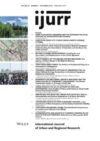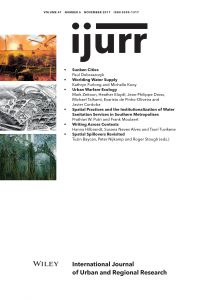Volume 41 Issue 6 November 2017
In This Issue...
Our latest issue of IJURR brings together a fascinating range of papers with despatches from Basrah, Jakarta, Tallinn, and many other cities. The comparative dimension to urban studies is elaborated through global perspectives on urban studies that can trace developments through contrasting settings to generate new insights. We explore infrastructure systems above ground as well as underground cities and the hidden reaches of modernity. The prospect of drowned cities under future climate change scenarios is examined as a focal point for different urban imaginaries. Building on previous debates in IJURR the idea of infrastructure is re-conceptualized across a range of different axes as a complex palimpsest of different forms, structures, and institutionalized traces. We also consider the obverse of building modernities through the impact of war on urban space: the lens of urban ecology is extended to epidemiological and humanitarian dimensions to the deliberate destruction of urban infrastructure. In different ways these papers highlight a range of vulnerabilities and uncertainties facing contemporary cities: it is clear that the research imagination must be open to multiple possibilities and different lines of enquiry. Recurring focal points for urban analysis such as creativity, ecology, and resilience are in a constant state of critical reformulation and re-invention.
— Matthew Gandy
Articles
Sunken Cities: Climate Change, Urban Futures and the Imagination of Submergence
Published online on Nov 14th, 2017 | DOI: 10.1111/1468-2427.12510 (p 868-887)
Worlding Water Supply: Thinking Beyond the Network in Jakarta
Published online on Dec 5th, 2017 | DOI: 10.1111/1468-2427.12582 (p 888-903)
Urban Warfare Ecology: A Study of Water Supply in Basrah
Published online on Dec 5th, 2017 | DOI: 10.1111/1468-2427.12546 (p 904-925)
Spatial Practices and the Institutionalization of Water Sanitation Services in Southern Metropolises: The case of Jakarta and its Kampung Kojan
Published online on Nov 21st, 2017 | DOI: 10.1111/1468-2427.12549 (p 926-945)
Writing Across Contexts: Urban Informality and the State in Tallinn, Bafatá and Berlin
Published online on Dec 5th, 2017 | DOI: 10.1111/1468-2427.12583 (p 946-961)
Symposium
Spatial Spillovers Revisited: Innovation, Human Capital and Local Dynamics
Published online on Nov 20th, 2017 | DOI: 10.1111/1468-2427.12557 (p 962-975)
Towards a New Conceptualization of Innovation in Space: Territorial Patterns of Innovation
Published online on Nov 20th, 2017 | DOI: 10.1111/1468-2427.12556 (p 976-996)
Creating an Environment for Economic Growth: Creativity, Entrepreneurship or Human Capital?
Published online on Nov 20th, 2017 | DOI: 10.1111/1468-2427.12555 (p 997-1009)
The Geography of Innovation in China and India
Published online on Nov 20th, 2017 | DOI: 10.1111/1468-2427.12554 (p 1010-1027)
Book Reviews
Richard Florida 2017: The New Urban Crisis: How Our Cities are Increasing Inequality, Deepening Segregation, and Failing the Middle Class –– and What We Can Do About It. New York: Basic Books
Published online on Dec 5th, 2017 | DOI: 10.1111/1468-2427.12571 (p 1028–1029)
Stephen Graham 2016: Vertical: The City from Satellites to Bunkers. London: Verso
Published online on Dec 5th, 2017 | DOI: 10.1111/1468-2427.12572 (p 1029–1030)
Oliver Coutard and Jonathan Rutherford (eds.) 2016: Beyond the Networked City: Infrastructure Reconfigurations and Urban Change in the North and South. London: Routledge
Published online on Dec 5th, 2017 (p 1031–1032)
Martina Löw 2016: The Sociology of Space: Materiality, Social Structures, and Action. New York: Palgrave Macmillan
Published online on Dec 5th, 2017 | DOI: 10.1111/1468-2427.12574 (p 1032–1034)
Antonio Loris 2015: Water, State and the City. London and New York: Palgrave Macmillan
Published online on Dec 5th, 2017 | DOI: 10.1111/1468-2427.12575 (p 1034–1035)
Rowland Atkinson and Sarah Blandy 2017: Domestic Fortress: Fear and the New Home Front. Manchester: Manchester University Press
Published online on Dec 5th, 2017 | DOI: 10.1111/1468-2427.12576 (p 1035–1037)
Françoise Montambeault 2016: The Politics of Local Participatory Democracy in Latin America: Institutions, Actors, and Interactions. Stanford: Stanford University Press
Published online on Dec 5th, 2017 | DOI: 10.1111/1468-2427.12577 (p 1037–1039)
Robert Saliba (ed.) 2015: Urban Design in the Arab World: Re-conceptualizing Boundaries. Farnham and Burlington, VT: Ashgate
Published online on Dec 5th, 2017 | DOI: 10.1111/1468-2427.12578 (p 1039–1040)
Issues in this volume
January 2017
March 2017
May 2017
July 2017
September 2017
November 2017

